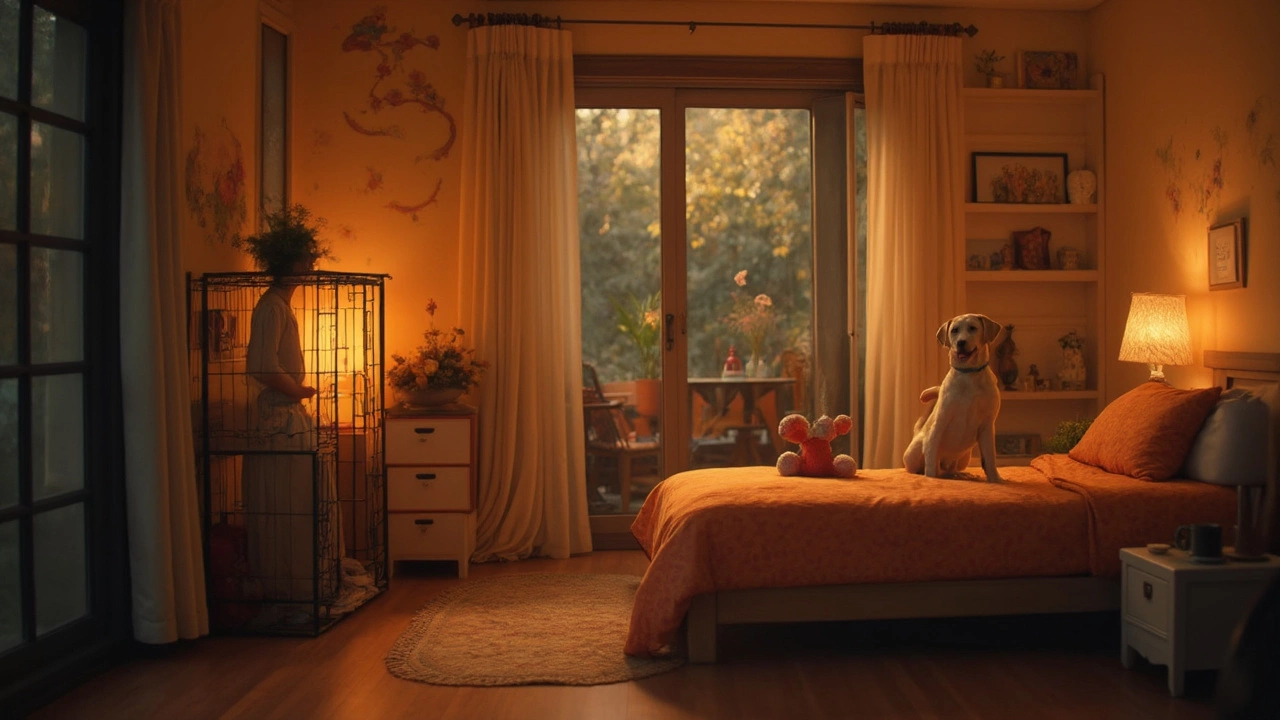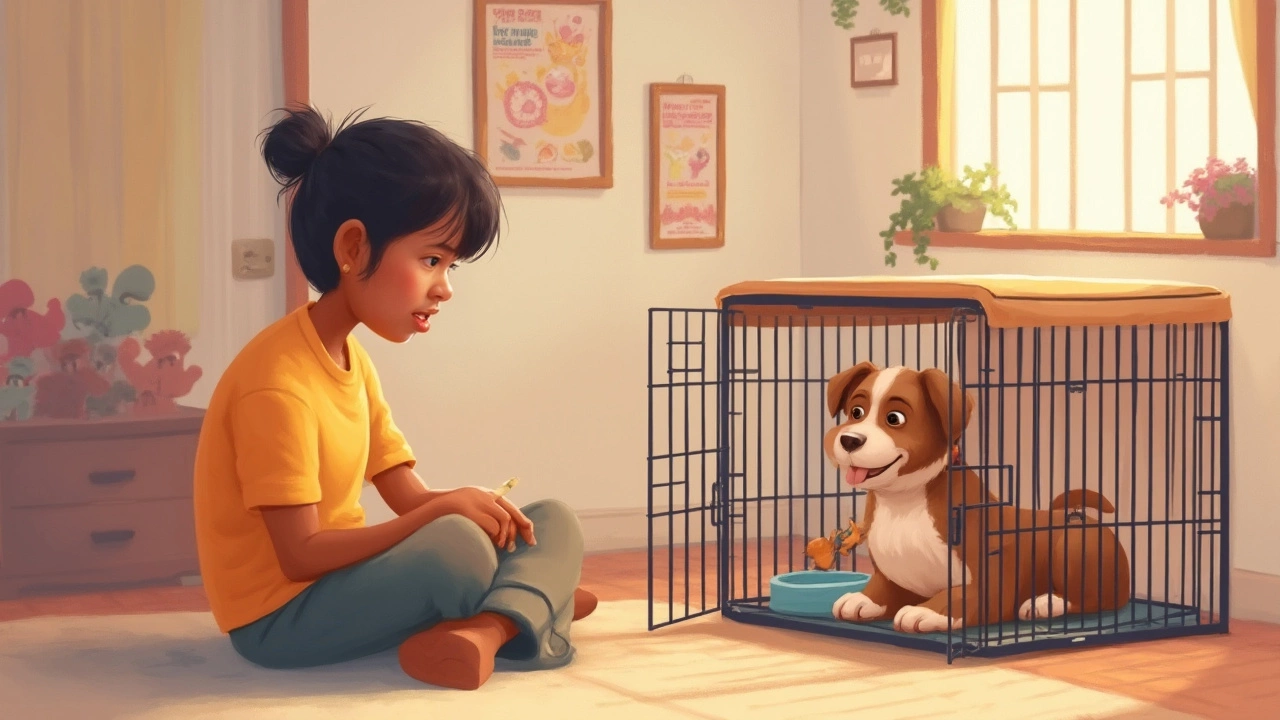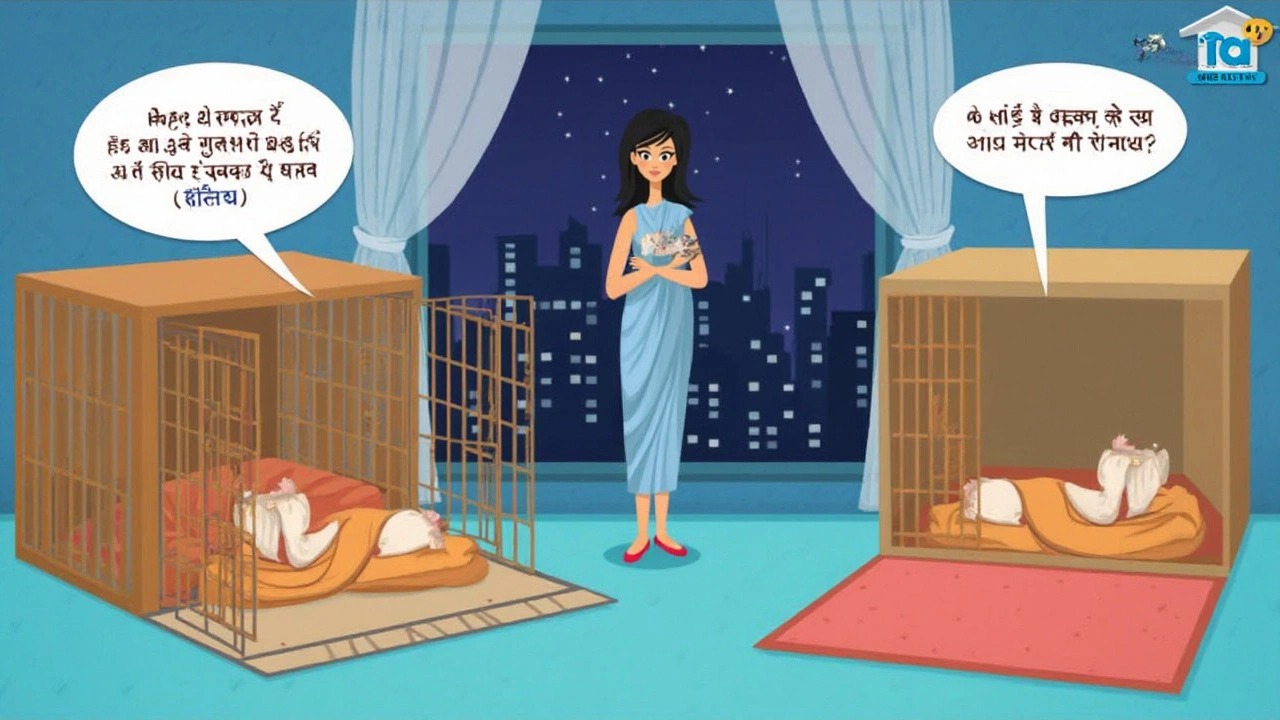
Ever wake up to the sound of toenails skittering down the hallway—or worse, find mystery puddles in the morning? You're not alone. Crate training at night is one of those polarizing topics in the dog world. Some people swear by it; others can't imagine shutting their pup in a crate after dark. So, what’s the real scoop?
Let me spare you the guesswork: crates can be useful, but it’s all about how (and when) you use them. The goal isn’t to lock your dog away for eight hours. It’s to give them a spot where they actually feel comfortable, like a cozy den. My dog Luna took to her crate pretty quickly, but only after I stopped treating it like doggy jail.
Here’s what’s often missed—dogs are den animals by nature. A crate can help them settle, avoid accidents, and steer clear of nighttime mischief, especially during the chewy puppy phase. But there are right ways and wrong ways to go about it. Start with good info, skip the myths, and make sure your buddy feels safe and relaxed, not punished or alone.
- Why Crate Your Dog at Night?
- How to Make the Crate a Safe Space
- Potential Downsides and How to Avoid Them
- Common Mistakes and How to Fix Them
- When Crates Aren't the Answer
Why Crate Your Dog at Night?
There are solid reasons why dog crate training at night has stuck around. Dogs feel safer with routines, and a crate gives them boundaries that make nighttime less chaotic for everyone in the house. You know that sense of relief when your phone battery is full? That's pretty much what a dog feels inside a familiar crate—calm, secure, no surprises.
One big plus: fewer bathroom accidents overnight. Puppies can’t always hold it, and even adult dogs sometimes get anxious or bored and make a mess. Crates encourage them to wait until morning, since dogs naturally avoid soiling their own space.
- Less destruction: Chewers and explorers can’t access shoes or furniture if they’re settled in a crate while you sleep.
- Better sleep: Some studies show that crates help dogs fall asleep faster and stay asleep, which means more rest for you, too.
- Easy travel: If your dog likes their crate, trips to the vet, groomer, or even vacations get way less stressful.
Ever had an emergency and had to evacuate with a pet? Many shelters or hotels only accept dogs in crates for safety reasons. Teaching your dog to settle in a crate gives you options when things get hectic.
| Benefit | Why It Matters |
|---|---|
| Prevents midnight potty breaks | Dog learns to hold it longer |
| Reduces anxiety | Dogs feel safe in their own "den" |
| Protects your stuff | No chewed cables or shoes in the morning |
So when you’re weighing the whole "Should I put my dog in a crate at night?" question, think about these practical upsides. It isn't about making your dog feel trapped; it’s about making life smoother—for you and your dog.
How to Make the Crate a Safe Space
Turning the crate into a place your dog actually wants to be isn’t as hard as you might think. Dogs are smart—they figure out quickly if something is worth their time. If you want dog crate training to work at night, the crate needs to be connected with good things, not isolation or punishment.
First, make sure the crate is the right size. It should be big enough for your dog to stand up, turn around, and flop down. Too small and your dog will feel cramped. Too big and you might end up with accidents because dogs like to keep their sleeping areas clean but will use a far corner if you give them too much room.
- Comfy bedding: Toss in a soft mat or blanket—just make sure it’s machine washable, because accidents happen. Some dogs like a piece of your old t-shirt, since it smells like you.
- Safe toys: Give a chew-safe toy or stuffed Kong. This keeps your pup entertained and helps with those night-time nerves.
- Location matters: Put the crate somewhere your dog can see or hear people, at least at first. Luna settled down way quicker when her crate was in my bedroom.
Want your dog to actually go into the crate by choice? Make it part of daily life. Feed them meals in there. Drop in treats out of the blue. Avoid using the crate as a punishment zone—otherwise, it’ll become a ‘bad vibes only’ spot. Some trainers say that if you put treats or toys inside and calmly close the door for short periods while you’re in the room, it helps big time with dog anxiety around the crate.
Let’s look at some quick stats from a 2024 survey of dog owners:
| % Owners Who Say Their Dog Settles Quietly in the Crate | Crate is in Bedroom | Crate is in Living Room |
|---|---|---|
| 78% | Bedroom | 47% |
Keeping the crate close at night really does help most pups feel less alone. Over time, most dogs see their crates as their own spot—a safe zone, not a cell. That’s what makes crate at night routines actually stick.

Potential Downsides and How to Avoid Them
Using a dog crate at night isn’t always smooth sailing. Some dogs love it; others fight it tooth and nail—or paw and nose. Here’s what could go sideways and how to steer clear of bigger problems.
Crate Anxiety: Some dogs get stressed out in a crate, especially if they’ve had a bad experience or the crate just feels lonely. Signs? Barking, whining, biting the bars, and, sometimes, bathroom accidents despite being house-trained.
- Start slow. Let your dog explore the crate when it’s not bedtime, maybe toss in treats or a favorite toy so it’s a positive spot.
- Don’t use the crate for punishment. If your dog only winds up in there after doing something “bad,” they’ll never see it as safe.
- Keep the crate in your bedroom at first. This way your pup can still sense you nearby, lowering the freak-out factor.
Physical Discomfort is another stopper. Too small, and your dog can’t turn around; too big, and it feels less den-like, which can actually make them more anxious.
- Pick the right size. Your dog should be able to stand, turn, and stretch out.
- Add a comfy bed or blanket, but skip anything your dog might shred and swallow—especially if they’re still in the chewing stage.
Too Much Time in the Crate: Experts warn not to leave your dog in a crate for more than 6-8 hours, except maybe overnight for adult dogs who handle it well. Puppies can’t hold it that long and can get separation anxiety.
| Dog Age | Max Time in Crate Overnight |
|---|---|
| 2-3 months | 4-5 hours |
| 4-6 months | 6-7 hours |
| Adult | Up to 8 hours |
Lastly, watch for subtle signals—if your dog suddenly hates bedtime, has new accidents, or looks stressed, something’s off. Tweak things or give them a break from the crate for a night. Remember, the best dog crate training happens when you pay attention to your dog’s signals and keep their comfort front and center.
Common Mistakes and How to Fix Them
Even dog lovers who mean well mess up when it comes to dog crate training at night. So, what usually goes wrong? Here are the classic pitfalls and how to dodge them.
- Using the crate as punishment: If your dog only gets crated when they’re in trouble, guess what? They’ll hate it. Instead, teach them good stuff happens in there—treats, dinner, chill time with a favorite toy.
- Too much time locked in: Your dog isn’t supposed to become a crate potato. Dogs really shouldn’t be crated for more than 6-8 hours, especially puppies. They need bathroom breaks and brain breaks.
- Ignoring signs of anxiety: Whining all night? Panting? Chewing the crate? These aren’t dogs being "dramatic." They're stressed. That’s usually a sign you’re going too fast or missing something important in your dog training process.
- Uncomfortable crate setup: An empty metal box? No thanks. Make it cozy—use a soft bed, a safe chew toy, and ditch anything squeaky that could keep you up. Too hot or too drafty isn’t good, either.
- Skipping the bedtime routine: If you just toss your dog in and leave, they won’t know what’s happening. Pick a simple routine—potty break, low-key cuddle, into the crate, and then lights out.
Fixing these mistakes isn’t rocket science. It’s really about making your dog’s crate a spot they love, not dread. Want to see how the basics add up? Check out this quick side-by-side:
| Mistake | Quick Fix |
|---|---|
| Crate as punishment | Only use crate for good things |
| Over-crating | Give regular breaks and exercise |
| Ignoring anxiety | Go slower, reward calm |
| Uncomfy setup | Make it soft and familiar |
| No bedtime routine | Build in a simple wind-down process |
If you stick with these tips, you’ll avoid the usual trouble and see way better results with your crate at night system. Luna tried every trick in the book to skip bedtime, but once I fixed my setup and routine, she started going in on her own. Give your dog the same shot—and you might just get your own good night’s sleep back.

When Crates Aren't the Answer
Crates are not a one-size-fits-all solution. There are some cases when crate training at night just doesn’t work out—and that’s totally okay. Let’s get into the real reasons why sometimes a dog crate training plan needs a different direction.
First off, some dogs seriously panic in crates. We’re not talking minor whining or the classic sad-puppy-dog eyes. True separation anxiety can be a deal-breaker. If your dog drools excessively, soils the crate, bites at the bars, or shows signs of distress even after loads of positive crate experiences, it could make things worse. Forcing a dog with high anxiety into a crate isn’t just stressful—it’s risky. Dogs can hurt themselves trying to escape. This isn’t rare, either; animal behaviorists estimate that up to 17% of dogs show moderate to severe crate anxiety when left too long.
Health also plays a big part. Dogs struggling with arthritis, hip dysplasia, or other mobility problems just aren't comfortable in crates, even with soft bedding. Senior dogs may need extra room to stretch, or might get stiff after a few hours curled up. Not to mention puppies who need frequent midnight bathroom breaks—if you're using a crate to stop accidents, but your young pup can't physically hold it all night, you're playing a losing game.
Then you have the scenario where your dog just flat-out prefers an open space. Some dogs sleep best sprawled out on a dog bed in the living room or snuggled next to your feet. If your dog never digs the crate no matter how much you try, and isn’t destructive or anxious at night, why force it?
- Medical needs: Dogs with chronic pain, breathing issues, or severe allergies might do worse in enclosed spaces.
- Past trauma: Rescue dogs, especially those from neglectful backgrounds, may see crates as punishment, no matter how kind you are.
- Long periods alone: If you’re gone a lot, the crate can magnify feelings of isolation. Dogs are social—they need more contact, not less.
If you’re hitting these roadblocks, try one of these alternatives:
- Set up a cozy exercise pen with toys and a safe bed.
- Dog-proof a small room, like a laundry room or bathroom, using baby gates.
- Train your dog to sleep on a dedicated dog bed instead of free roaming.
Here’s a quick look at issues that mean it might be time to ditch the crate:
| Situation | Why Crates Don't Work |
|---|---|
| Severe separation anxiety | Escalates stress, potential for injury |
| Medical problems | Discomfort, increased pain, health risk |
| Senior dogs | Stiffness, lack of space, old age adjustments |
| Long work hours | Social isolation, boredom |
| Past traumas | Fear response, set back training |
With crate at night questions, always watch your dog’s reactions. If bedtime in the crate is a battle every night even after weeks of consistent training, it’s probably a sign to find another setup. Your dog’s comfort comes first, and sleeping should be a safe and chill experience for everyone.




